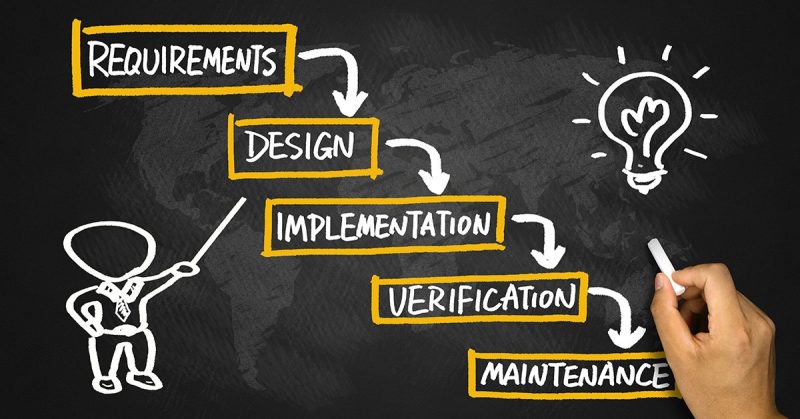The waterfall model is one of the most well-known strategies of software development, which became the basis for other modern methods of project delivery.
The software development life cycle as a system of interrelated processes is different for others. In some cases of projects, when the waterfall model is useless, it is better to follow Agile, Spiral, Lean, Critical Path, or other approaches.
Contents
Waterfall model description and structure
The waterfall model represents SDLC as a clear linear sequence, where the previous step should be finished before the team can proceed to the next one. This method is known from the publication “Management the development of large software systems” by Dr.Winston W. Royce back in 1970. The waterfall model consists of five stages:
- gathering requirements
- designing the solution
- implementing the solution
- testing and QA
- support and maintenance
Requirements gathering
The first stage is about establishing system requirements. Software engineers communicate with the customer to identify and document business and technical requirements. This stage finishes with the delivery of a Vision&Scope document and Software Requirements Specification (SRS).
The Vision&Scope document contains the concept of the final goal and determines what is included in the project. It has a great value for the client because it gives a clear view of what will be done. The Scope contains the roadmap, budget, and the description of basic functions described in the Vision part.
Also, it is important to make the Software Requirements Specification at this stage, which should describe all the functionality that the customer wants to see in the ready software.
Solution design
This stage helps the development team and customers see how exactly the requirements will be technically realized. This is about choosing the most effective programming languages, technologies, and defining services.
Implementation
It is time to write the source code, realize the business logic, and build service integrations. The code writing process can be divided into the delivery of several blocks, each of which should go through the functionality testing and assembled into the system.
Quality Assurance
The product should pass quality checks and testing, which is necessary to verify that all problem areas are detected and addressed. The team of QA engineers can use the bug tracking system to solve problems during the maintenance stage.
After the bugs are fixed, the software product can be transferred to the client. The client also can test the product to evaluate it in the working process.
Maintenance
This stage consists of the app implementation into the live environment, with the following support and maintenance. The software engineering team ensures the long-term seamless performance of the product functionality.
Waterfall model: for and against
Waterfall, like other software development models, has its strengths and weaknesses and suits specific businesses.
For using Waterfall
The waterfall model is clear to use and easy to implement. Its main pros include the following ones:
- Suits large companies with a complex hierarchy;
- Easy and transparent project management;
- Precise and complete documentation;
- Little to no unplanned costs;
- Clear project results.
Against using Waterfall
Though it may seem that the approach is free of flaws, the Waterfall model has its cons as well:
- There is no way to measure current progress. Until the product is ready (at the end of the life cycle), you cannot notice and fix errors.
- A change in schedule at one stage affects all stages of the project.
- Corrections of the business model elements or the required functionality influence the results of the previous stages.
- The project delivery time is extended.
The waterfall model is a suitable option for (A) short projects with constant requirements (alternatively, it is better to choose Agile) and (B) companies with complex management systems. It consists of a clear sequence of actions, and the development team cannot proceed to the next stage until the previous stage has been completed and documented.
Have you ever tried the waterfall model for your software development project? Let’s discuss it below!





